The Retrofit Demand Gap

The last home improvement initiative by government was called a 'slam dunk fail' so what needs fixing?
The numbers this year still aren't good.
At FutureBuild 2024 we interviewed David Pierpoint of the Retrofit Academy.
David is one of the very earliest adopters of the retrofit ethos, the equivalent of actually being at the first Glastonbury, not the latest.
With that depth of knowledge and experience comes a level of wisdom. When we spoke to David he was very clear he wasn't happy.
David Pierpoint from THE RETROFIT ACADEMY Interviewed at FutureBuild 2024
David pointed out that it was incredibly difficult to recruit 200,000+ retrofit professionals if they couldn't easily find training, didn't know career paths existed and had no knowledge of the earning potential of the sector.
There is a difficulty in developing new training schemes, awareness is one thing as is occupational standards. The Retrofit Academy is on one of the market leaders in providing retrofit training, has consistency of training and yet the messaging is still slow to leak out.
But this is an important point - the Retrofit Academy, although one of the best is just one of many component parts of the retrofit agenda, and the industry needs a boost.
Root Problems
In our interviews this year we have received conflicting opinions about the strategy required to implement effective communications about retrofit.
One organisation Arup who have a pioneer of retrofit in the figure of Steve Fernandez;
Steve Fernandez Retrofit Pioneer at ARUP
yet in the same organisation they have a leading figure who in an embarrassing 'hot mic' incident dismissed a key component in retrofit, bio materials as an irrelevance. But to be fair - the comment was in relation to 'lack of demand'.
This example epitomises the often conflicting ideas and beliefs of senior leaders who are supposed to be anchoring our efforts to decarbonise buildings.
Difference of opinion is crucial in any development project, we need dynamic change but a lack of focus and consistent messaging is damaging.
It plays into the hands of the lobbying teams who manage to endorse the demands of the gas and oil industries and cripple the developments in retrofit and reuse.
Dysfunction in approaches to communicating retrofit could be eliminated if we create demand.
Then we'd have no room for arguments, because everyone would be working like billy-O to get stuff done.
Creating Demand
The editor of this magazine just completed the first stages of retrofit assessor training.
The training did a thoroughly good job of highlighting the range of construction available in the UK, that needs to be retrofitted.
It also created a deeper level of understanding about the complexities of the UK housing and commercial stock.
The lack of knowledge most people have, about the homes they live in and the office or places they work in. Is an opportunity.
If you give people the choice, of a warmer (or cooler), safer, healthier work and living environment, they will take it.
But at the moment, that audience isn't interested, enough.
So we need to make them interested.
In order to create demand.
We have help at hand.
Chris Walker + Pherezhivanie = Demand Generation
There is a well known subject matter expert in the demand generation space, Chris Walker. He works with companies in the Software as a Service (SaaS) sector and has a ground breaking podcast which is like a school for marketers.
Chris Walker Interviewed on Lead Gen and Demand Gen
We know that the idea of sustainability and retrofit is a proposition that people need to be introduced to who are in the 'non buying mode'.
We also know that the research by people like Yekhaterina Brobrova around feelings and emotion can influence the change in mindset to get people to buy in to retrofit.
And we have cast iron examples of successes from companies like Grosvenor and the social housing successes of Civic Square that when your audience is INFORMED and feels empowered they make choices that change the course of the way they think of the buildings they live and work in.
Communicate, Communicate, Communicate
If you are serious about contributing to our net zero goals.
You are going to need to use a magic combination of emotion and reasoning, with a dash of marketing pzazz to reach the people who need what you have.
The zeitgeist in the UK right now is for change. It's in the ether. Tools like demand generation strategy, the HCF concept, and the advanced concepts developing in the working groups of the National Retrofit Hub signal we are getting there.
But in order to create demand for retrofit, for refurbishment, for reuse. We need to communicate better. Now.
This month we'll be interviewing Imandeep Kaur, one of the pioneers at Civic Square to unpick how a generational change in mindset is occurring, why it's essential and how it's going to overcome the Retrofit Demand Gap.
If you want people to change they need to know what the future can look like.
